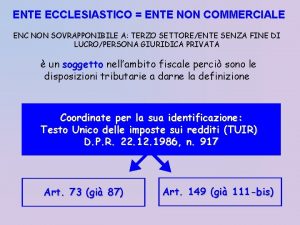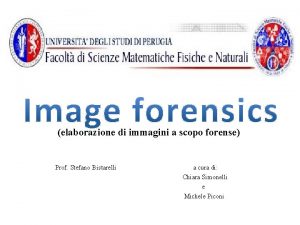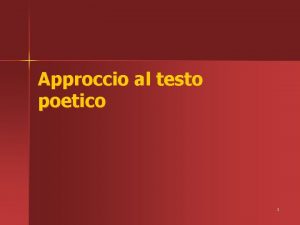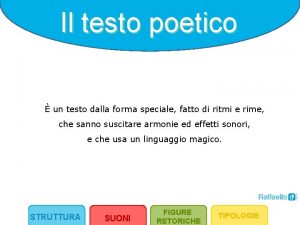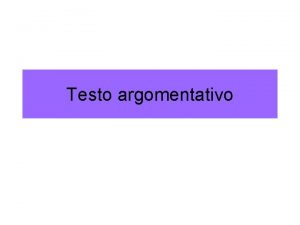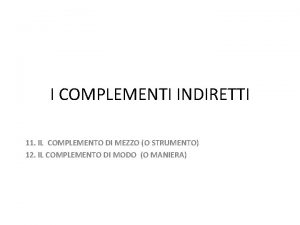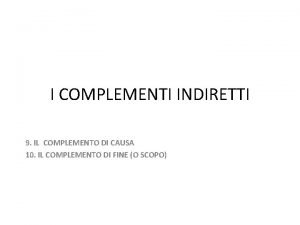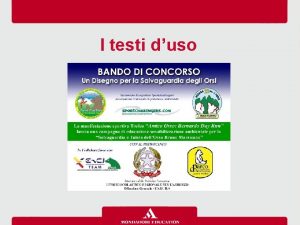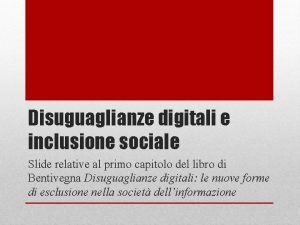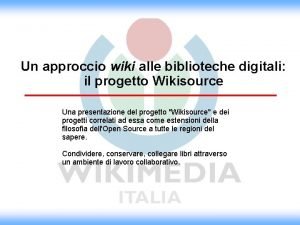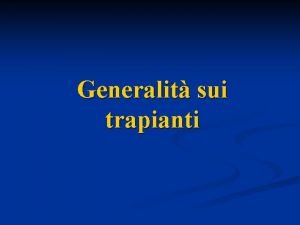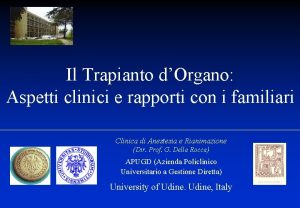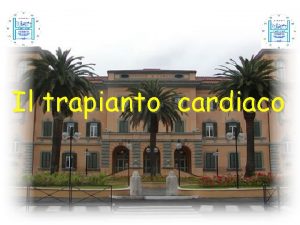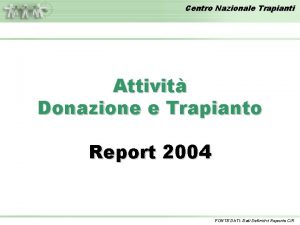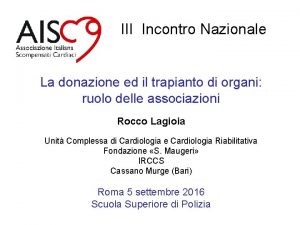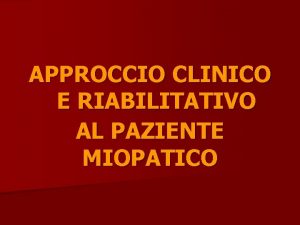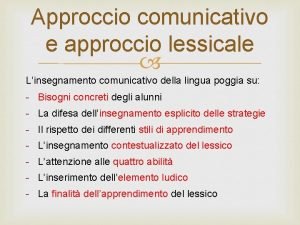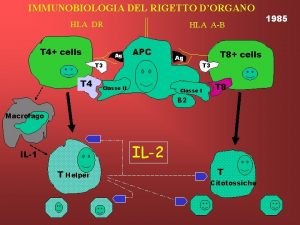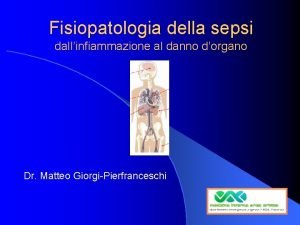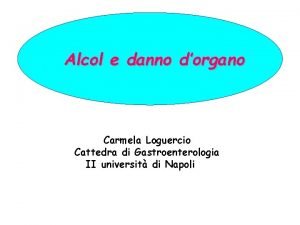APPROCCIO MINIINVASIVO NELLA DONAZIONE DORGANO A SCOPO TRAPIANTO
















- Slides: 16

APPROCCIO MINIINVASIVO NELLA DONAZIONE D’ORGANO A SCOPO TRAPIANTO PEDIATRICO Roberta Angelico MD, Ph. D, FEBS Chirurgia Epatobiliopancreatica e dei Trapianti Addominali Ospedale Pediatrico Bambino Gesù, IRCCS, Roma CHIRURGIA ROBOTICA vs CHIRURGIA LAPAROSCOPICA TRADIZIONALE Chieti, 5 Aprile 2019

LIVING DONOR TRANSPLANTATION IN CHILDREN Why? ü Lack of size-match donor ü No waiting on the transplant list ü Elective procedure ideal timing for transplantation ü No deterioration / drop out / mortality on the waiting list Excellent outcomes! 2

LIVING DONOR TRANSPLANTATION IN CHILDREN 3 Limits ü Availability of donor ü Donor morbidity and mortality ü Technical complexity and difficult organization LIVER TRANSPLANTATION KIDNEY TRANSPLANTATION UNOS Data 2018

4 HOW TO IMPROVE LIVE DONATION? Donor mini-invasive surgery

5 PEDIATRIC LIVING DONOR LIVER TRANSPLANTATION Extended right lobe: segments I+IV-VIII Left lateral segment: segments II-III 70%-75% whole liver volume IDEAL GRAFT-TO-RECIPIENT-WEIGHT-RATIO: 1. 5 -3% 20%-25% whole liver volume

ADULT-TO-CHILD LDLT 6 mini-invasive donor surgery ü ≅ 200 laparoscopic donor procedures ü Donor morbidity: 0 -25% ü Donor mortality: 0% ü Conversion rate: 0 -6% ü Standardized technique Pan Au K et al. WJG, 2018 Han H et al. Dig Surgery, 2018

7

PEDIATRIC LIVER TRANSPLANTATION ACTIVITY 8 Ospedale Pediatrico Bambino Gesù 100% 95% 34 28 26 27 24 15 15 3 -77% 30% Living donor liver transplantation

9 Donor Mini-Invasive Left Lateral Sectionectomy OPBG experience Donor Recipients No. Age (yrs) Sex (M/F) Operation time (min) Ischemia Tot-Warm (min) Morbidity Age Sex (M/F) Diagnosis Morbidity 1 40 M 490 84 -5 No 12 m F Biliary atresia No 2 41 M 497 78 -4 No 1 y 4 m F Criptogenetic cholestasis Biliary stenosis 3 29 F 455 43 -5 IVC thrombosis 7 m M Biliary atresia PV thrombosis 4 37 F 480 78 -6 No 9 m M Biliary atresia PV stenosis 5* 44 M 465 60 -5 No 2 y 8 m F Intrahepatic familiar cholestsis No 6 32 M 440 45 -3 No 1 y 6 m M PH 1 No 7 35 F 482 123 -6 No 6 m F Biliary atresia No 8 35 F 540 83 -4 No 5 m F Biliary atresia No 9* 41 M 390 194 -5 No 2 y 10 m M PH 1 IVC thrombosis 10 34 M 420 69 -3 Biliary leak 2 y 8 m F Biliary atresia No 11 35 F 500 162 -6 No 6 m M Biliary atresia Outflow stenosis 12 43 M 475 82 -5 No 2 y 9 m F Ductopenic cirrhosis No 13 47 M 505 50 -4 No 5 y F Alagille’s syndrome No Period: July 2016 -April 2019 * Sequential living-related kidney transplantation

10 Donor Mini-Invasive Left Lateral Sectionectomy OPBG experience Donor Recipients No. Age (yrs) Sex (M/F) Operation time (min) Ischemia Tot-Warm (min) Morbidity Age Sex (M/F) Diagnosis Morbidity 1 40 M 490 84 -5 No 12 m F Biliary atresia No 2 41 M 497 78 -4 No 1 y 4 m F Criptogenetic cholestasis Biliary stenosis 3 29 F 455 43 -5 IVC thrombosis 7 m M Biliary atresia PV thrombosis 480 78 -6 No 9 m M Biliary atresia PV stenosis 465 60 -5 No 2 y 8 m F Intrahepatic familiar cholestsis No M 440 45 -3 No 1 y 6 m M PH 1 No Clavien Grade 1: 0% F Grade 2: 15% M Grade 3: 0% Grade 4: 0% 4 37 5* 44 6 32 7 35 F 482 123 -6 No 6 m F Biliary atresia No 8 35 F 540 83 -4 No 5 m F Biliary atresia No 9* 41 M 390 194 -5 No 2 y 10 m M PH 1 IVC thrombosis 10 34 M 420 69 -3 Biliary leak 2 y 8 m F Biliary atresia No 11 35 F 500 162 -6 No 6 m M Biliary atresia Outflow stenosis 12 43 M 475 82 -5 No 2 y 9 m F Ductopenic cirrhosis No 13 47 M 505 50 -4 No 5 y F Alagille’s syndrome No Period: July 2016 -April 2019 * Sequential living-related kidney transplantation

LIVING DONOR KIDNEY TRANSPLANTATION 11 Gold standards: ü Pure laparoscopic nephrectomy ü Hand-assisted nephrectomy Walther AE et al. Pediatric Transpl. , 2015

12 PEDIATRIC RENAL TRANSPLANTATION Ospedale Pediatrico Bambino Gesù 96% 28 26 Log-Rank= 0. 292 83% 2018 43% living donor kidney transplantation Log-Rank= 0. 273

13 Sequential laparoscopic liver-kidney procurement in the same living donor Donor Age (yrs) 1 2 32 40 Sex (M/F) Liver surgery Kidney surgery F Laparoscopic left lateral sectionectomy Laparoscopic left nephrectomy M Laparoscopic left lateral sectionectomy Hand-assisted right nephrectomy A C B D Recipients Morbidity No No Time between L-K surgery 8 m 4 m Age 15 m 34 m Sex (M/F) Diagnosis Morbidity M primary hyperoxaluria type 1 No M primary hyperoxaluria type 1 IVC thrombosis

14

15 Conclusions ü Mini-invasive approaches in donor liver resection might improve donor outcome and potentially increase the donor pool ü Laparoscopic LLS for pediatric LDLT is considered a safe and feasible procedure with potential advantages when performed in expert centres ü Pure laparoscopic and hand-assisted nephrectomy are the gold standard for living donor liver nephrectomy ü The referral to pediatric transplant center with expertise in living donation and laparoscopic surgery is essential for good outcome

16
 Regni romano barbarici cartina
Regni romano barbarici cartina Donazione a favore di ente ecclesiastico tassazione
Donazione a favore di ente ecclesiastico tassazione Scopo la prof
Scopo la prof La struttura del testo narrativo
La struttura del testo narrativo Fresche le mie parole nella sera
Fresche le mie parole nella sera Analisi testo argomentativo esempi
Analisi testo argomentativo esempi Rima
Rima Forme del testo poetico
Forme del testo poetico Frase subordinata significato
Frase subordinata significato Rima invertita esempio
Rima invertita esempio Accoglienza testo argomentativo
Accoglienza testo argomentativo Qual è il complemento indiretto
Qual è il complemento indiretto Complemento di causa
Complemento di causa Il testo descrittivo ha lo scopo di mostrare
Il testo descrittivo ha lo scopo di mostrare Complemento di causa
Complemento di causa Approccio dicotomico
Approccio dicotomico Approccio wiki
Approccio wiki

